Introduction
Product Tour
The Canon EOS 60D is an 18 megapixel digital SLR built around an APS-C sensor and a Digic 4 image processor. The new 60D is an upgrade to the popular 50D, and represents the middle of Canons lineup, above the T2i, but below the 7D and the 5D Mark II. It uses the Canon EF lens mount, which makes it compatible with a huge range of lenses, from ultra wide angles to ultra long zooms. It is priced at $999 for the body only and $1299 with an 18-135mm zoom lens.
Front
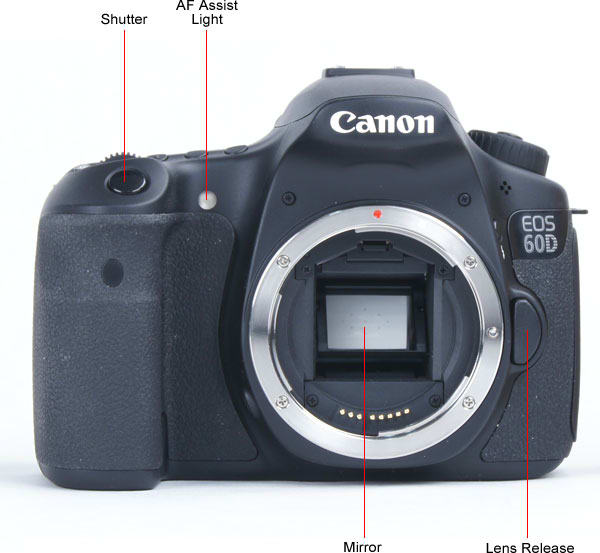
Back
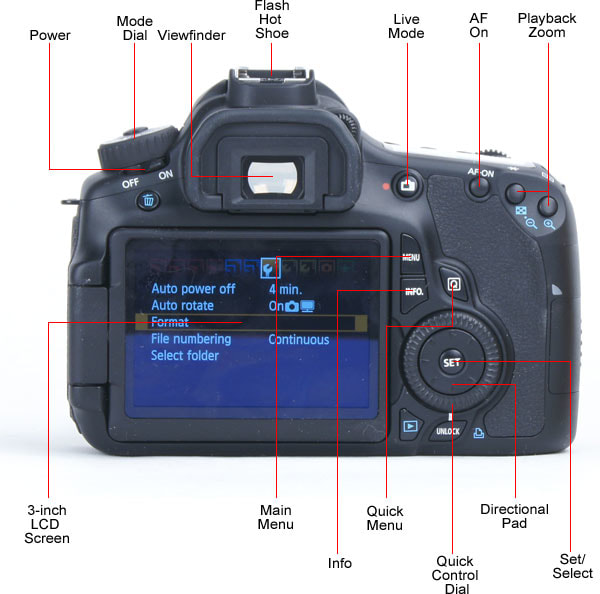
Sides
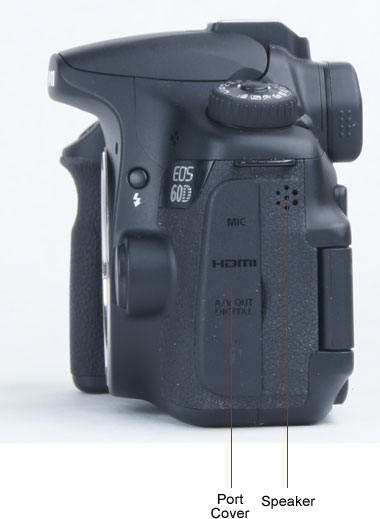
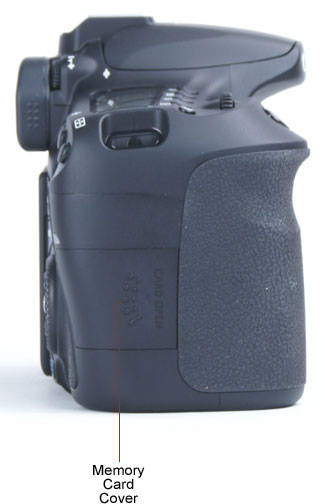
Bottom
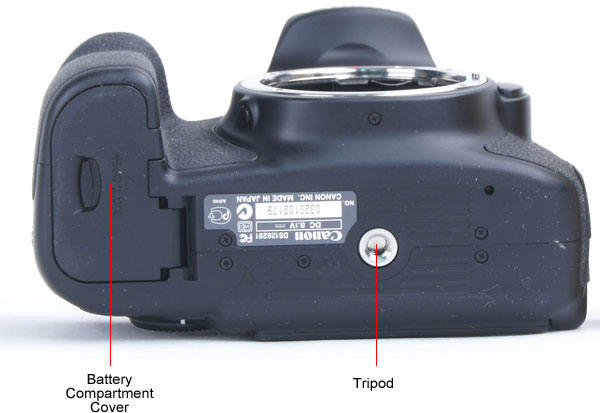
Top
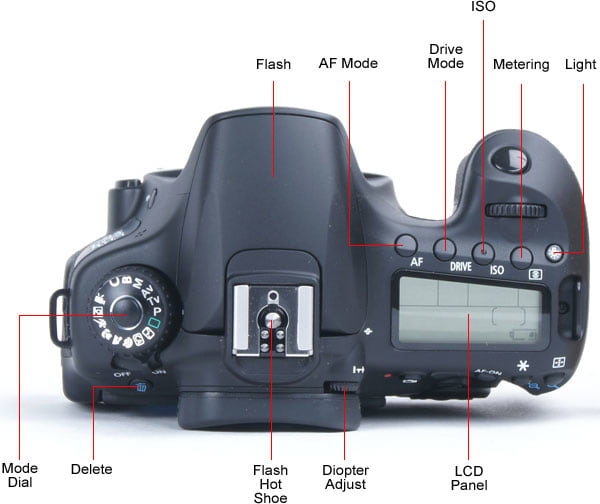
**Size Comparisons **
**In the Box **
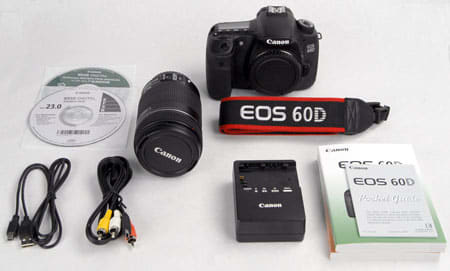
As well as the camera, you get:
• LP-E6 battery pack
• LC-E6 charger
• Neck strap
• USB cable
• Analog A/V output cable
• EOS Software CD
• Manual on CD
• Instruction book
• Pocket guide
Not included is a HDMI cable or a memory card: you'll need to buy your own.
Color
**Color Accuracy *** (17.47) *
Our first test looks at the color accuracy of a camera: how accurately can it capture the range of colors that form photos? To test this, we photograph a color chart with 24 color patches and compare the captured image with the original chart. In this test, we found that the 60D captured extremely accurate color in most of the picture modes it offers, with the Faithful mode being the most accurate by a whisker. The only colors that it struggled to capture were the some of the blues and reds, both of which were a little more vivid than the subtle originals. The 60D aced this test, though, getting one of the highest scores for color accuracy that we have ever seen. Click here for more on how we test color.
NOTE: Because of the way computer monitors reproduce colors, the images above do not exactly match the originals found on the chart or in the captured images. The chart should be used to judge the relative color shift, not the absolute captured colors.
In comparison with other cameras, you can see that the 60D was the winner by a significant margin, outscoring even the more expensive Canon 7D and earning a higher score than the Nikon and Sony cameras.
Color Modes*(5.00)*
The 60D offers only a limited selection of color modes: 6 preset ones and three user defined ones. The 6 presets (which Canon refers to as Picture Modes) are Standard, Portrait, Landscape, Neutral, Faithful and Monochrome, while the 3 user defined ones can be customized by changing settings for sharpness, contrast, saturation and color tone. These color modes are different to the similarly named scene modes that are available from the mode dial, although a scene mode may include a picture mode. Sample crops from a Gretag Macbeth color chart shot in 5 of the modes (the presets, excluding monochrome) are shown below.
NOTE: Because of the way computer monitors reproduce colors, the images above do not exactly match the originals found on the chart or in the captured images. The chart should be used to judge the relative color shift, not the absolute captured colors.
Long Exposure*(10.09)*
In our long exposure test, we look at how the color accuracy and noise levels change as the camera takes images with exposure times of between 1 and 30 seconds. Many cameras struggle here, but we found that the 60D did well: shooting in low light with an ISO of 400, the noise actually seemed to decrease as the exposure time increased. We also look at if the cameras built-in long exposure noise reduction reduced the image noise: the answer for the 60D was that it did reduce the noise, but only very slightly. Click here for more on how we test long exposure.
We found that the color error did climb as the shutter speed got longer, with the largest color error at a 30 second exposure. But the climb was minor, and the color error remained comparatively low across the shutter speed range.
We also look at the amount of noise in our test images, and we found that the amount of noise fell as the shutter speed increased. Enabling the long exposure noise reduction did reduce the amount of noise in images, but only by a small amount. It also slows the shooting speed, as it works by taking another exposure with the shutter closed and subtracting this from the real image (a technique called dark field subtraction). This means that, with a 30 second exposure, you have to wait another 30 seconds after the shot is taken for the camera to take the second one before you can see the final image or shoot another one.
Noise
Noise*(6.63)*
Noise is the stuff that ruins your digital photo, the staticky overlay that makes images look less attractive. It is caused by electronic noise inside the image sensor, and the 60D, like all digital cameras, is prone to picking this up when capturing photos. We found that the 60D was a little noisier then some other cameras, although images shot in low light with plenty of light contained a low level of noise. Things did get a little noisy when we cranked up the ISO to shoot in low light, though. Click here for more on how we test noise.
Our first test looks at the amount of noise in images, and how well the camera deals with this. The 60D offers 4 levels of noise reduction, ranging from disabled to strong. As the graph above shows, the noise climbs as the ISO increases, but the noise reduction can reduce it somewhat when on the higher settings. There is a price to pay, though: the images loose some detail that the camera confuses with noise: see the examples below.
If we look at the noise in the different color channels with the NR disabled, we can see there the red noise is a little higher than others, but not significantly.
If we compare the 60D to other cameras with noise reduction off or at the lowest setting, we see that the Canon 60D follows the same basic trend. The Sony SLT-A55 is lower than the other cameras, but that is partly because this camera does not allow you to disable the noise reduction completely: you can only set it to weak.
Comparing the noise reduction at maximum produces a similar pattern: the 60D follows the same trend as other cameras. For examples of the different levels of noise reduction, see the sample photos section.
ISO*(7.00)*
The normal ISO range of the 60D goes from 100 up to 6400 by default, but this can be expanded up to ISO 12800 by enabling a custom function. We have included samples with this expanded range below, but Canon does not enable it by default for a reason: images get rather noisy above ISO 1600.
*NOTE: The images above are not used in our testing or scoring, but are included here to show real-world examples of the differences between cameras at the various ISO settings. *ISO settings above 6400 are only available on the 60D by enabling the custom feature I-3: ISO expansion. This is disabled by default. *
Resolution
Resolution*(11.90)*
Our resolution tests look at the level of detail that a camera can capture. The more detail, the more realistic images will look. This is about more than just the pixel resolution that the camera captures: it is about how much detail they can get and how much distortion and other issues get in the way. We found that the 60D and the 18-135mm zoom lens that it is sold with did a decent job here: the overall resolution of images was high, although we did find a few issues with the kit lens. Our overall conclusion is that the 60D can capture a very good level of detail, but that the lens that Canon sells with the camera has some issues. If you are looking for the highest quality images, it would be worth spending some money on better lenses to get the most out of the 60D. Click here for more on how we test resolution.
Distortion
The 18-135mm zoom lens that is sold with the 60D introduces some distortion into images: we found that there was only a very small amount of distortion at the wide and telephoto ends of the range, but there was some significant distortion in the middle and at the long end of the zoom range.
*Chromatic Aberration (7.12)
*Chromatic aberration is caused by the elements of the lens diffracting colors of light differently, causing a colored fringe at the edge of objects. We found that there was some aberration going on with the 18-135mm lens, especially at the wide and telephoto ends of the zoom range.
***Sharpness (13.95)*
We found that the 60D was capable of capturing very sharp images, but that this was let down somewhat by the performance of the 18-135mm zoom lens that Canon bundled it with. We can tell this because the sharpness in the center of the frame of our test photos was very high, but the sharpness at the edges was much lower. Basically, the 60D is a camera that can capture very sharp, clean images, but the included lens lets it down. If image quality is critical to you, buy the 60D without a lens and spend the money you save on buying some better lenses.
Shooting at the wide end of the zoom range, we found that the images were sharp in the center of the frame across the aperture range, but the edges of the frame were a different story: they were rather soft at both the widest and smallest aperture. There was also a noticeable amount of chromatic aberration in all of our test images at the edge of the frame.
Things were a little sharper in the middle of the zoom range, but there were still issues, with the images taken at the smallest aperture being rather soft.
At the long end of the zoom range, we found the same issues as above with slightly soft edges leading to a loss of detail, especially at the smallest aperture.
Picture Quality & Size Options*(10.75)*
The D60 offers a good range of image size and quality options, with the size options shown in the table below. All of these offer two different quality levels, described as Fine and Standard. Unusually, the 60D also offers three size settings for RAW images (which contain the raw data from the image sensor for maximum quality): the full raw image, M-RAW and S-RAW. The full RAW images contain about 18 megapixels, while RAW M and RAW S images contain 10.1 or 4.5 megapixels respectively.
Dynamic Range*(8.46)*
Dynamic range is a measure of how much detail a camera can capture in the shadows and highlights. The wider the dynamic range, the more detail it can capture, and the more realistic the captured images will look. We measured the widest dynamic range that the 60D could manage at 7.48 stops, just a whisker less than the Canon 7D. As the ISO increased, the dynamic range that the camera captured decreased, because of the increasing noise in the images. However, the speed at which the range decreased was not significantly lower or higher than other cameras. Click here for more on how we test dynamic range.
The chart above shows how the dynamic range decreases as the ISO increases, falling to 2.37 stops at ISO 6400.
When we compare the widest dynamic ranges that our comparison cameras can capture, the 60D comes out well, with only the 7D having a wider range.
Image Stabilization*(7.39)*
The 60D uses Canon's lens based image stabilization (IS) system, where an element of the lens moves in response to the camera shake detected by the camera body. We have generally found Canons to have effective image stabilization, and the 60D is no exception: we found that it did a good job of correcting for camera shake in our tests, especially at the longer shutter speeds. It is not perfect, though: we found that it sometimes made things a little worse at shutter speeds above 1/60 of a second. Our reccomendation would be to leave it turned on if you are shooting indoors or in relatively low light. One thing to bear in mind here: because the IS system is built into the lens, the performance will be different with different lense than the one we tested with (the 18-13mm kit lens). Click here for more on how we test image stabilization.
In the low shake portion of our test (which simulates hand shake while trying to hold the camera steady), you can see that the IS didn't make much difference at the higher shutter speeds, but it did improve the sharpness of the image at speeds of 1/30 of a second and slower. The high shake (which simulates hand shake while walking) produced quite different results, with the system seemingly struggling to keep up, and it seemed to make things worse at the mid-range shutter speeds.
White Balance
White Balance*(6.48)*
White balance is how a camera compensates for different lighting sources. If a camera can correctly white balance, the colors will look the same as the original. If it can't, images will come out with an orange or blue color cast. We test this by photographing a color chart under a variety of lighting sources, and analyzing the resulting images. We found that the 60D was generally able to white balance correctly, but it struggled with incandescent lighting. Click here for more on how we test white balance.
Automatic White Balance (7.54)
Our first test looks at the auto white balance setting, where the camera judges the white balance after taking a photo and compensates. We found a low color shift with the simulated daylight and fluorescent light sources, but there was a fairly significant shift with incandescent lighting: the whites had a distinct orange cast to them.
If we compare the performance of the 60D to other cameras, we see that most had no problem with the simulated daylight in our tests: all had a low color error.
All of them struggled with the incandescent lighting, though, and all produced images with a significant color error.
The 60D had a more significant color error with the fluorescent light source than the other cameras, but this is not a huge concern: the color error is still minor.
Custom White Balance (5.41)
Next, we test with using a custom white balance, where we take a photo of a white card and allow the camera to use this to calculate the correct color balance. This produced much smaller color errors than the automatic setting, and it underlines the benefit of using a custom white balance where possible.
White Balance Settings*(8.00)*
The 60D offers a good selection of white balance presets and custom features, with 6 presets (listed below) and a direct entry setting. Unusually for a high-end SLR, there is only one custom white balance memory spot, so you can't store several different settings to use in different locations.
- The flash setting is set to 6000k for most standard flashes, but certain Canon Speedlites can set another temperature.
**** The user can input a number in the indicated range.
Sample Photos
Sample Photos
Still Life Examples
Below are photos of our still life taken at a range of ISOs from the 60D and our comparison cameras. Click on any image to see the full sized, unedited original image.
NOTE: The images above are not used in our testing or scoring, but are included here to show real-world examples of the differences between cameras at the various ISO settings.
Noise Examples
Below are crops from the images above.
NOTE: The images above are not used in our testing or scoring, but are included here to show real-world examples of the differences between cameras at the various ISO settings.
Playback
Playback Mode*(9.50)*
The playback system for both stills and movies works well, with controls that make it easy to quickly scroll through photos. The rear control dial makes it easy to spin through a lot of images quickly, with the control dial skipping through 10 images at a time. The control dial can also be configured to skip through 100 images, to skip by shooting date (so you can skip a day), by folder or by rating if you rate individual photos. We would have liked to have seen the ability to have more than 9 thumbnail images on screen at a time, though, because that seems like a waste of the high resolution screen.
A basic slide show feature is also offered, which is a strictly no-frills affair: you can select to play all files or just one folder of files, or to show just movies or still images. You can also set the duration of each image and the transition between them, but that's it: no music or other fancy tricks. For a camera like this, that's all that is needed, though.
In-Camera Editing*(3.00)*
Canon has added a few extra editing features over the 7D. As well as rotating images, you can apply a number of creative filters, such as grainy B/W, soft focus, a toy camera effect or a tilt-shift miniature effect. While these might find some use on a point & shoot camera, we doubt they will get much use in this camera for serious photographers, who will want to do any special effects in a more fully featured image editing program.
Software*(8.00)*
A full-featured software bundle is included for both Windows and Mac users, including powerful versions of the expected RAW file development and photo browsing applications plus a welcome utility program that allows camera control from your computer via USB connection. Support software for the Wireless File Transmitter accessory and Original Data Security Kit are also included for both platforms.
Direct Print Options*(5.00)*
Both DPOF and PictBridge are supported by this camera. DPOF (Digital Print Order Format) allows you to tag images for later printing, while Pictbridge allows you to connect the 60D directly to a printer to print images out.
Hardware
Sensor*(3.00)*
The 60D is built around an APS-C sized CMOS sensor, which measures 0.88 by 0.59 inches (22.3 by 14.9mm). This is the same image sensor that is used in the Canon T2i and the 7D, and it captures 18 megapixel images with a maximum resolution of 5200 by 3462 pixels or Full HD video at 1920 by 1080 pixels at 30, 25 or 24 frames per second. It is actually a 19 megapixel sensor with a resolution of 5432 by 3492 pixels: the extra pixels are used in the image stabilization system.
This sensor is twinned with a Digic 4 image processor chip, and this is one of the areas where the otherwise similar Canon 7D has an advantage: the more expensive 7D has two image processing chips, making it quicker to process and save images.
Viewfinder*(9.75)*
Like all SLRs, the 60D offers an optical viewfinder that shows the through the lens image, so you can see exactly what the image sensor will be seeing. At the bottom of the frame is a small LCD strip that show shooting information such as the shutter speed, aperture, ISO setting, etc.
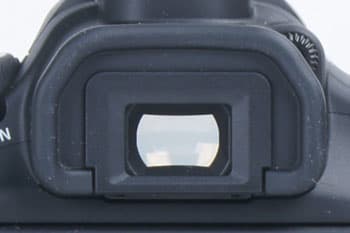
The viewfinder of the 60D
When the 60D is shooting images, the viewfinder goes momentarily blank as the mirror flips up to allow the light to pass through to the image sensor. The 60D also offers a live view mode that shows a live preview of this captured image on the LCD screen (see below).
LCD*(11.10)*
The LCD screen is one of the major upgrades from the 50D: the 60D offers a 3-inch, 1004k pixel LCD screen that is very clear and bright, showing a great level of detail for both captured images and the live view preview. This screen is also articulated: a pivot on the side of the LCD screen allows it to flip out to the left of the camera body and to rotate180 degrees up or 90 degrees down. What this means is that it can be flipped and rotated so you can see the screen from in front, above or below the camera for self portraits or shooting from above or below.


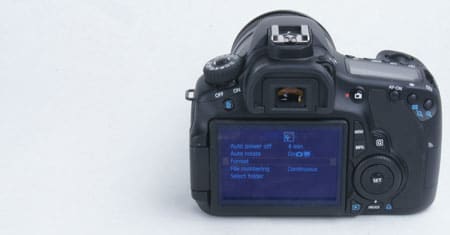
The LCD of the 60D in three different orientations
This hinged arrangement feels very tough: the LCD hinge and pivot is unlikely to break without severe force. And it also allows the LCD screen to be folded flat against the camera body, where it is protected from damage from bumps and knocks when stored in a camera bag.

*The top LCD of the 60D
*
The 60D also offers a secondary LCD screen on the top of the camera body which shows shooting information such as the current mode, aperture and shutter speed, white balance setting, etc. The page from the manual that shows the full information is below.

UPDATE: Due to a production error, a previous version of this review contained incorrect information on the secondary screen. This has been corrected.
Flash*(6.00)*
The 60D has two flash options: a small built-in flash, or a hot shoe that allows you to attach a more powerful external flash. the built-in flash is a small pop-up device that is built into the housing for the viewfinder. This automatically pops up when needed in full auto modes, or it can be activated by pressing the button on the left side of the camera body, near the lens mount. We found that this flash unit was fine for very basic shots and for acting as a fill-in flash, but wasn't powerful enough to illuminate more than a few feet into the darkness.

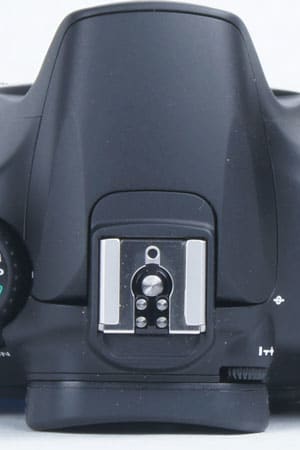
The built-in flash of the 60D (left) and the hot shoe
The other option is to add an external flash onto the hot shoe. Unlike certain other manufacturers (I'm looking at you, Sony), Canon has stuck with the standard hot shoe that allows any standard flash gun to connect. Of course, if you use one of Canon's own Speedlite EX-series flash guns, you get some extra features, such as TTL (Through The Lens ) metering and flash compensation. With other flash units, the synch speed can be adjusted to between 1/30 to 1/250 of a second.
Lens Mount*(10.50)*
The 60D uses Canon's own EF mount for lenses. This makes it compatible with a huge range of lenses, from ultra wide to ultra long zooms. The 60D is designed to work with the newer EF-S lenses, but it is compatible with the older EF type. Non-EF-S lenses, however, will get a 1.6x multiplier on their focal length because of the smaller sensor size, so a lens like the EF 24mm f1.4 becomes a 38mm lens. This adds a free boost to telephoto lenses, but also reduces the angle of view of wide angle lenses.

The lens mount of the 60D
Lenses are easy to remove and install. To remove a lens, press the button on the right side of the lens mount and rotate the lens counter-clockwise. To install a lens, you just line up the white dot on the lens body with the white dot on the lens mount, and twist the lens clockwise until it clicks into place. The 60D is sold as a kit with an 18-135mm, and the zoom examples shown below are taken with this lens.
Battery*(9.00)*
The 60D is powered by a large battery that fits into the camera grip. This battery (the LP-E6) holds up to 1800 mAh of charge, and Canon claims that this will last an impressive 1600 shots with no flash or 1100 shots with. This is an ambitious claim, but it seems to be borne out: we were able to go through several days of intense shooting during our testing without having to recharge the battery.

The battery of the 60D
The battery is charged in the included charger: there is no way to charge the battery within the camera itself.
Memory*(3.50)*
The 60D has a memory card slot which supports SD, SDHC and the newer SDXC memory cards. This is one of the differences between the 60D and the more expensive 7D, which uses the larger CompactFlash memory cards.

The memory card slot of the 60D
Jacks, Ports & Plugs*(6.50)*
The 60D has a number of ports under a rubber panel on the left side of the camera body. From the top, we have a microphone input, a mini HDMI port, a USB port and a wired remote port. The USB port also doubles as an analog video & audio output with the included cables. Missing from the 7D is an external flash trigger.

The ports of the 60D
Controls
Shooting Modes*(13.00)*
The 60D offers a good selection of shooting modes that provides plenty of flexibility for the user.
Live View*(5.9)*
The live view mode of this camera is started by pressing the live view button, to the right of the viewfinder. This flips up the mirror, blanking out the viewfinder and showing a preview of the image captured by the sensor on the screen. Although this mode has been improved since previous Canon models, it is still something of a compromise.
Focusing is the main compromise. The 60D offers three live view focusing modes: AF Live, Face Detection or AF Quick. AF Live is the default, where the camera uses the image sensor to focus by changing the focus of the camera, checking the image for sharpness, then changing the focus again. This is somewhat slow, with the lens stuttering as it changes the focus point. In this mode, focusing often takes 3-4 seconds, which could mean a lost shot.The Face Detection mode is similar, but it uses detected faces as the focus points.
The AF Quick mode is (as the name suggests) quicker. When you press either the shutter halfway down or the AF-On button, the mirror flips down and the camera uses the dedicated focusing sensors to focus on any of the 9 focus points. This usually happens in less than a second, although it can take a little longer with close-up objects. When the camera has focused, the mirror is flipped up again and the live preview resumes, with a number of small dots on the screen indicating which focus points are now in focus. Although the process is quicker, the screen goes blank while focusing, which is seriously distracting. Plus, if you use the AF-On button to focus and then press the shutter, the focusing process happens again, meaning another possibly lost shot because of the delay.
The bottom line here is that the live view focusing mode is seriously awkward either way, especially compared to the Sony SLT-A55, which uses a translucent mirror that allows it to focus with the dedicated sensors and show a live view preview at the same time.
The preview provided in live view mode looks clear and bright, with only moderate blurring and tearing when you pan or tilt the camera. The Q button also provides quick access to the same controls found in the normal shooting mode, but with a side-screen menu that is similar to the ones found on point & shoot cameras.
Although the live view mode of the 60D is improved over previous models, it is still awkward and inflexible. If you want to use live view a lot, this may be a serious inconvenience, and you may be better off with a camera with a better live view mode, such as the Sony SLT-A55 or another mirrorless camera that is more designed around live view.
Scene Modes*(3.66)*
The 60D only offers 5 scene modes, but they cover most of the areas that are likely to be needed. All are available directly from the mode dial on the top of the camera body.
Picture Effects*(4.00)*
The 60D offers a number of Picture Modes, which tweak the image in particular ways to achieve the desired look. All of these modes can be tweaked using 4 controls: sharpness, contrast, saturation and color tone.
Focus*(14.00)*
The 60D offers 9 focus points arranged in a diamond shape around the center of the frame, with one point in the center of the frame. All of these points are the cross type, but the center focus point is a dual cross type, which is more effective with both horizontal and vertical edges: Canon claims double the sensitivity for the center point over the others. 9 focus points is significantly less than many other cameras: the Sony SLT-A55 offers 15, and the Canon 7D offers 19, which provides more flexibility in choosing where in the frame to focus. Also missing is the zone system of the 7D, which allows the user to select a zone of AF points to use.
Switching between the focus points is done by pressing the set button. The user can then select an individual point with the control dial or the directional pad, or select all points so the camera will get as many into focus as possible.

The focus points layout of the 60D
There are three focusing modes on offer.
A full manual focus is also available by flicking the switch on the lens body. When in full manual mode, the camera helps a little by flashing the focus points that it detects as being in focus when the shutter is half pressed down.
Exposure*(6.00)*
The 60D provides a good level of control over exposure, with exposure compensation of ±5 stops in 1/2 or 1/3 of a stop increments. Bracketing is also offered for both exposure and white balance, shooting 3 frames at up to 3 stops apart.
Speed and Timing
Shot to Shot (5.22)
Running in the high speed continuous mode, we found that the 60D could shoot about 5.2 frames per second (fps), a touch below the 5.3fps that Canon claims. That's a very decent speed, and is only a little slower than the 7.49 fps of its more expensive cousin, the 7D. We found that it slowed down significantly after about 40 shots with the Lexar Professional 4GB SDHC card we tested it with as the camera had to wait to write data out to the memory card. Still, that's a lot of photos: a burst of around 7 seconds should cover most eventualities. The camera also provides an indication of the maximum burst in the viewfinder: a number on the far right shows the probable maximum burst that the camera can handle with the current settings.
The numbers above show that the 60D is a little slower than our comparison cameras: only the Samsung NX10 is slower.
Drive/Burst Mode (7.5)
The 60D offers two burst modes: a high speed mode that shoots around 5.3 fps, and a low speed mode that does about 3 fps.
Depth of Field Preview*(2.00)*
A dedicated button below the lens offers a depth of field preview by stopping the lens down to the selected aperture. The button is rather awkwardly placed on the lens mount housing, meaning that you have to reach around to press it.
Metering*(8.50)*
The usual selection of metering modes are available, with options to let the camera make the call or to use a small spot to meter the scene.
Shutter Speed*(10.00)*
The shutter speed of the 60D ranges from 1/8000 of a second out to 30 seconds. Longer shutter times can be achieved with the bulb mode, which locks the shutter open for as long as the shutter button is pressed.
Self-Timer*(3.00)*
A 2 and 10 second self timer delay are available, and the 60D is compatible with a Canon wired remote: the RS-60E3. There is no face or smile detection shutter, though, which are features available on most point & shoot cameras.
Design & Handling
Handling*(9.00)*
The Canon 60D is in the middle of the range in terms of size: it is larger than the T2i, but smaller than the 7D. However, the size differences between this and the 7D are small: it has the same hefty feel, especially with the large 18-135mm kit lens. It fits comfortably into the hand, with the large grip and textured coating that makes for a good tight grip.
The overall size and weight is reduced slightly from the EOS 50D, the model the 60D replaces in the line up.
Controls*(11.00)*
There are a lot of buttons, controls and dials on this camera: 21 buttons and 3 dials. These are laid out in a consistent fashion, though, with the most commonly used buttons falling near the fingertips when holding the camera in two hands, so you can easily change the ISO level or drive mode without looking away from the viewfinder. Most of the controls on the back of the camera are designed for use in live view mode or when accessing the menu on the main LCD screen, but the AF-on button is within reach of the thumb. One interesting design touch is the mode dial. To stop this being accidentally turned, Canon has added a button that has to be pressed for the dial to turn, so you can't accidentally change modes while handling the camera.
Canon also carried over one useful feature from the 50D: an additional scroll wheel on the back of the camera body. In the 60D, this sits around the directional pad, which is a positive move, as it provides for quick scrolling through images and menus, as well as controlling aperture in manual mode and exposure compensation in other modes. It is possible to reach down and turn this with the thumb with the eye to the viewfinder, but it is awkward to turn it more than 45 degrees: you have to turn the dial, move the thumb, turn the dial, etc. This is a bit of a pain when trying to go from a wide to a small aperture.
Despite this, the 60D is overall an extremely easy camera to use and shoot with once you get used to the layout, and 50D users will quickly feel at home here. Canon T2i users should also be able to find their way around after a brief familiarization period.

Most of the controls are on the back of the camera. Of particular note are the live view buttons near the top and the Q and main menu buttons.

More controls are located on the top of the camera, including a group of 5 buttons near the LCD panel and the power switch below the mode dial.
Menu*(8.75)*
The 60D has two types of menu: the quick menu accessed with the Q button and the main menu. The idea is that the quick menu provides quick access to shooting controls such as exposure compensation, drive mode, etc. The main menu contains these and the lesser-used options, such as memory card formatting.
Manual & Learning*(7.25)*
The 60D comes with a full printed manual in both English and Spanish. This manual is well illustrated and indexed, covering all of the advanced features of the camera in some depth. A pocket guide is also included that offers a quick visual guide to the main features of the camera.
Video Color & Noise
**Video: Color Performance***(11.04)*
No matter what color mode we used to record video with the Canon 60D the camera consistently rendered accurate colors in our bright light testing. Using the standard color mode, which is the setting we used to score all of our video testing, the 60D managed an excellent color error of 3.17 and a saturation level of 98.08%. Certain color modes produced some slightly better results, however. The 60D did best using its portrait color mode, which resulted in a 2.79 color error. Click here for more on how CamcorderInfo.com tests color performance.
Above, you can see the specific colors that the 60D had trouble with, as well as checking out the tones that the camera did a good job rendering accurately. The camera was nearly perfect with rendering blue colors, while reds and greens gave it some problems. As for the various color modes, you can see examples of each in the table below.
Most video-capable DSLRs do a decent job in our bright light color accuracy tests, but the Canon 60D produced some of the most accurate colors we've seen. Particularly impressive, is the fact that its color accuracy was better than the Canon 7D in bright light (although the 7D did better in our low light color accuracy test).
**Video: Noise Performance***(9.37)*
While the 60D did turn in one of the more impressive color accuracy performances we've seen from a video-capable DSLR, the camera didn't do as well in our bright light noise tests. The Canon 60D averaged 0.64% noise in this test, which is more than double the amount of noise we measured from the Canon 7D. Still, it is important to note that this isn't a bad performance—particularly when the 60D's numbers are compared with most consumer camcorders (it's just not quite as good as the other DSLR cameras we compared it to). Click here for more on how CamcorderInfo.com tests noise performance.
From the crops above you can see that the Canon 60D captured s fairly sharp image, although it's lines aren't quite as bold as what we saw from the Canon 7D. The Samsung NX10, which is the only camera in this set that does not capture Full HD video (it tops out with a 1280 x 720 resolution) has a much blurrier image than the competition. There's also some moire problems and discoloration in its 100% crop image shown above.
Video Motion & Sharpness
Video Low Light Performance
**Video: Low Light Sensitivity***(8.38)*
The Canon 60D needed 8 lux of light to pass our sensitivity test, which is a fine score for the DSLR camera. It's the same amount of light that the Canon 7D needed in this test, though, so it appears Canon didn't make any improvements (or worsen) the video low light sensitivity on its new DSLR. Click here for more on how CamcorderInfo.com tests low light sensitivity.
Like the 7D, the 60D managed the same low light sensitivity in both its 24p and 30p record mode. Of course, if you want to improve the low light sensitivity of the camera you could always switch to a faster lens with a wider aperture setting. This allows more light to hit the image sensor while you are recording. Not that this is all that necessary with the 60D—check out the table below and you'll see it performed better in this test than both the Sony SLT-A55V and Samsung NX10.
**Video: Low Light Color Performance***(9.51)*
The Canon 60D's color accuracy numbers in low light were essentially unchanged from its numbers in our bright light test. The camera produced a color error of 3.12 with a saturation level of 102.3%. These are both good scores and they are similar to the numbers we usually see from video-capable DSLRs in this test. Click here for more on how CamcorderInfo.com tests low light color performance.
We like the image produced by the 60D in our low light test, but it is interesting to note that its colors were a tad less vivid than what the Canon 7D produced (see below). This isn't a bad thing necessarily, as it all depends how saturated you like your colors to be. Besides, you can manually adjust color saturation or use a different color mode if you wish (both Canon DSLRs offer this feature). The Sony and Samsung cameras shown below both produced much darker images in our low light tests compared to the two Canon models.
**Video: Low Light Noise Performance***(9.58)*
The 60D measured 1.205% noise in our low light noise test. If the 60D were a camcorder, then we'd say this is a perfectly acceptable (or even top-notch) score. But, the fact that the 60D is a DSLR makes the competition a whole lot tougher, as video-capable DSLRs often put up impeccable numbers in this test. The Canon 7D and the Sony SLT-A55V, for example, both averaged a lot less noise in this test than the Canon 60D. Click here for more on how CamcorderInfo.com tests low light noise performance.
Noise precentages aside, the best way to determine the quality of low light video is to actually look at it. The crops above are an attempt to illustrate this quality (they're pulled from our low light test). NThe 60D has a strong, bright image, but it does lack the sharpness and finer detail that you can see from teh Canon 7D and Sony SLT-A55V. Still, we were very impressed with the 60D's overall low light performance, as it did well in all three of our low light tests.
Video Features
**Video: Compression***(7.50)*
The Canon 60D uses the MPEG-4 codec to compress video, which is the same compression system utilized by the Canon 7D. These MPEG-4 clips are a bit different than the AVCHD files that you'll find on most consumer camcorders. For starters, you can drag and drop the MPEG-4 video clips right from a memory card onto your computer (and play them instantly). If you import them to certain editing programs, however, you'll have to render the clips before you can work with them fully.
The camera has multiple recording options, all of which are listed in the table below. There are two Full HD settings, a 720p HD mode, and a 640 x 480 standard definition record mode. There's also a 640 x 480 crop setting that is essentially a zoomed-in version of a 1920 x 1080 recording.The crop mode gives your video a 7x telephoto zoom effect that is essentially a digital zoom.
The Canon 60D also has another trick up its sleeve that may be advantageous to people who will be using the camera overseas. You can switch the video mode between NTSC and PAL in the camera's menu. When shooting in the PAL system, the frame rate options on the camera change from 24p to 25p and from 60p to 50p (30p is available in both PAL and NTSC). This feature will probably be ignored by most users, but certain advanced videographers should be pleased with its inclusion.
**Video: Manual Controls***(6.75)*
The 60D offers mainly the same manual controls as the Canon 7D camera, which is to say it includes quite a bit. The 60D even added a few features, like the ability to change ISO during video recording, that make it the best video-capable DSLR we've seen in terms of how much control it offers.
Auto Mode
The Canon 60D does not have a continual live autofocus feature, which is basically the one control the camera doesn't include. You can use autofocus in video mode, but you must press the AF button or hold the shutter button down halfway (like you'd do to focus a photo). This is annoying, but it is par for the course with video-capable DSLRs. Only new DSLR-esque cameras like the Micro Four Thirds models include continual autofocus features. If this is something that is very important for you to have, we recommend going with a camcorder instead—all of them have autofocus mechanisms that work quickly.
If you have the exposure mode set to auto on the 60D you cannot adjust shutter speed, aperture, or ISO manually. You can make basic exposure control adjustments with EV values, however. To access the shutter, aperture, and ISO controls you must switch the camera over to manual exposure mode in its menu.
Zoom Controls and Zoom Ratio
How much zoom you get with the 60D depends on what kind of lens you have attached to the camera. The kit lens we used in our testing was an 18mm - 135mm, which is close to a 7.5x zoom. If you want more zoom, you can use the 640 x 480 crop record mode, which adds another 7x telephoto zoom to your video (it's a digital zoom, though).
Focus
There's no continual autofocus on the 60D, but you can manually focus using the large lens ring on the attached lens. This would be the recommended way to focus if you don't want the image to pop out of focus for a moment (it does this when you press the autofocus button), or if you really care about getting clean audio (the autofocus mechanism is very loud).
Exposure, Aperture, and Shutter Speed
All of these controls can be accessed and adjusted manually on the 60D either during video recording or before you start recording. The controls are easy to set—you simply rotate the dedicated dials—and the camera has a long list of aperture and shutter options.
ISO* and Other Controls*
The 60D has full ISO controls in video mode and you can even adjust them during video recording. We're not sure how many users will actually want to adjust ISO while recording video, but we're still pleased to see this feature available (more control is usually not a bad thing).
The camera also includes an electronic level, highlight tone priority (three dynamic range options), a grid display, and picture style options (which we show examples of in the Video: Color & Noise section of this review). Of course, the camera also has a full set of white balance controls that can work in video mode.
Canon added some extra audio features to the 60D that weren't present on the Canon 7D last year. For starters, the 60D has a manual audio level adjustment feature for its onboard mic and it also offers a wind filter option for cutting down on wind-related noise. When you consider how noisy the 60D is when you use it, this manual audio level control doesn't really come across as all that useful. The onboard mic consistently picks up clicks from dials in addition to the very loud autofocus mechanism. So, adjusting the audio levels won't really do anything to eliminate the noise factor. If you want clean audio with the 60D, you'll have to make use of the 3.5mm external mic jack, which is a far more useful feature.
Like most video-capable DSLRs, the Canon 60D is big and bulky. Because of this, you probably won't want to plan a full day of hand-held video recording with the camera unless you have supreme confidence in your arm strength. We'd recommend a tripod for long video shoots (besides, it'll make your videos less shaky anyway).
Despite its heaviness, the Canon 60D also has some very good handling aspects, the best of which is the rotable LCD. Unlike the Canon 7D, which offered a stationary LCD, the 60D's screen can fold out from the camera and rotate up to 270-degrees. It may not sound all that important, but this little touch does wonders for helping you get video recordings that would otherwise be a complete pain to shoot. You don't have to crane your neck or crouch when shooting on a tripod, for example. Simply put, all video-capable DSLRs should have an LCD like you get on the Canon 60D.
The most annoying thing about the 60D in terms of handling is the fact that the camera will overheat after prolonged periods of video-mode use. The live view mode, which is necessary for recording video, causes the camera's internal components to get to hot and, in turn, the 60D will automatically shut down when this occurs. Now, we only had this happen to us once during our testing (and it was after 30 - 40 minutes of straight use in video mode), but if you're doing a long day of shooting it is most likely going to occur. And, if it does, you must let the camera sit for a few minutes before you can use its video mode again. We should note, however, that this is a problem with many video-capable DSLRs (although Micro Four Thirds cameras usually don't have this problem).
Other good things about the 60D include its variety of manual controls, easy-to-read menus, and its dedicated video mode that makes things simple for the times you want to shoot video and nothing else. It's far from perfect, and it still has a number of the problems that have plagued video-capable DSLRs since there creation, but it probably has the best all-around setup we've seen from a DSLR that records video.
Canon EOS 7D Comparison
The differences between the two cameras look minor if you look at specifications, but they are significant. The 7D is the more expensive camera by about $600, but it shoots faster, has more focus points and uses CompactFlash cards.
Performance
The two camera tested quite similarly, which is not surprising as they both use the same image sensor. There were some important differences, though, with the 7D having a wider dynamic range, but the 60D having better color accuracy and slightly higher image sharpness. One thing to note here is that we tested the 7D with the firmware version that was available at release: Canon has since issued several firmware updates that may improve performance.
Components
It is probably quicker to discuss the differences between these two cameras than the similarities: The 7D has twin Digic processors, which makes for faster shooting. The 7D also has an adiitional flash controller connection. The major difference is the auto focus system: the 7D has 19 focus points, while the 60D has 9. All of the 7D focus points are also cross-type sensors, which can work better in low light, while the 60D only has one cross-type sensor in the middle of the frame. The 60D has one major plus over the 7D: the screen flips out and rotates, providing for more flexibility in where you shoot from.
Handling
Both cameras are covered with buttons and dials, but are easy to use once you get used to the layout. They also both have large, wide handgrips, which makes for a firm hold on the camera for run-and-gun shooting.
Controls
There are a few slight differences between the two cameras in the controls they offer. Both have a plethora of dials and buttons on the camera body, but the 60D has a directional pad rather than the multi-controller of the 7D. The menu and related buttons of the 7D are also relocated on the 60D to the right side of the screen to accomodate the hinge mechanism that allows the screen to flip out and rotate.
NOTE: The images above are not used in our testing or scoring, but are included here to show real-world examples of the differences between cameras at the various ISO settings.
Nikon D300S Comparison
Performance
The Canon 60D was the winner in most of our tests, with more accurate color, sharper details and better long exposure images. The Nikon D300S did shoot images faster, though managing to capture 7.13 frames a second. The Nikon also had the advantage in some of our video tests, capturing more accurate color and having a slight edge when shooting in low light. However, the Nikon is restricted to shooting 720p resolution video, while the Canon 60D can capture 1080p video at 30 frames a second.
Components
Both cameras offer large, clear 3-inch LCD screens for viewing images, but the 60D has the advantage of being able to fold out and tilt, so you can use it for shooting from above or below. The D300S has a fixed screen, but it does have both SD/SDHC and CompactFlash card slots, which makes it very flexible. You can even write to both cards at the same time if you need to give somebody a copy of an image quickly, and still keep a copy for yourself. The camera can also save RAW ot one and JPEG to the other, or switch from one to the other if it fills up the card, so you don't have to stop shooting.
Handling
Both cameras offer a live view mode, where the camera flips up the mirror and previews the image on the LCD screen. However, the live mode of both cameras is somewhat awkward, offering a compromise of slow auto focus or the screen going blank while the camera focuses. Both cameras have a large, chunky design that fits well into the hand, but the Nikon is the heavier camera body, although a lot depends on the weight of the lens that you use.
Controls
The 60D and the D300S are both covered with buttons and dials, which puts these controls within easy reach. Which one you will prefer depends partly on your experience: Canon users will feel instantly at home with the layout and menus of the 60D, while Nikon fans will prefer the D300S. The Nikon is a little easier to use when shooting in manual mode, though: the dual control dials make it a snap to quickly dial in an aperture and shutter speed, while the rear control dial of the 60D will need a lot of turning to select an aperture.
NOTE: The images above are not used in our testing or scoring, but are included here to show real-world examples of the differences between cameras at the various ISO settings.
Sony Alpha SLT-A55V Comparison
Performance
Many of our tests were a close fought thing between these two cameras, with both getting close scores for resolution and noise. The 60D was the better performer in our color accuracy test, though, and also captured better looking images from long exposures. The A55 was significantly faster, though, capturing an impressive 10 frames per second while the 60D could only manage just over 5 fps. Both cameras were good performers, though, capturing images with excellent sharpness and good color.
Both cameras also capture good looking video, but the 60D provides more flexibility, with manual controls that allow it to adapt to more shooting situations.
Components
The A55 is a much smaller and more compact camera, but both have big, bright 3-inch LCD screens that can be flipped up and down. The 60D has the more flexible screen, though because it is on a hinge that allows it to be folded flat against the camera body, protecting it from harm.
Handling
The 60D is the larger camera, but both are well designed to provide a good, solid grip. The A55 does a slightly better job of putting more control buttons within quick reach of thefingers and thub, but the 60D has the important ones close to hand.
Controls
Both cameras are also slightly awkward to use in manual mode. On the A55, you have to hold down a button to control aperture, while the rear dial of the 60D is awkward to turn to change apertures.
NOTE: The images above are not used in our testing or scoring, but are included here to show real-world examples of the differences between cameras at the various ISO settings.
Samsung NX10 Comparison
Performance
The 60D and the NX10 were evenly matched in some of our tests, but the NX10 did best the 60D in our long exposure and image sharpness tests. The 60D was the clear winner in our color accuracy tests, though, producing images with only very subtle shifts from the origionals in our test chart.
Components
Both cameras use a similarly sized image sensor, but what is in front of it is different: the 60D has a mirror, but the NX10 has nothing: the lens is right in front of the image sensor. The mirror on the 60D provides it with an optical viewfinder, while the NX10 offers an electronic viewfinder that shows the image the sensor sees. Both cameras do have similar LCD displays, though, at 3 inches.
Handling
The Canon is the larger of the two cameras by a significant margin: not having a mirror means that the NX10 can be much thinner and sleeker. But it is still bigger and bulkier than a compact point & shoot, so you can't just put it into a pocket: both cameras are going to end up around your neck, and both handle like SLR cameras.
Controls
Like most SLRs, both cameras have a large number of buttons, knobs and dials over their bodies. The Samsung has a smaller number, though, putting more features into on-screen menus. This is a double-edged sword: it keeps the camera simple, but it also makes it more cumbersome to change the settings. Those who are used to the way Canon does things will feel at home with the 60D, but those who are less experienced may be better off with the simpler NX10.
NOTE: The images above are not used in our testing or scoring, but are included here to show real-world examples of the differences between cameras at the various ISO settings.
Conclusion
Meet the tester
Richard Baguley is a veteran writer who has written about technology ranging from Alphabet to Zip file utilities. He has contributed to pretty much every major tech publication, including Amiga Format Magazine, PC World, Wired, CNET, Toms Guide, Forbes, and many others. He lives in the Boston metro area with his wife, dog, and an indeterminate number of cats.
Checking our work.
Our team is here to help you buy the best stuff and love what you own. Our writers, editors, and experts obsess over the products we cover to make sure you're confident and satisfied. Have a different opinion about something we recommend? Email us and we'll compare notes.
Shoot us an email